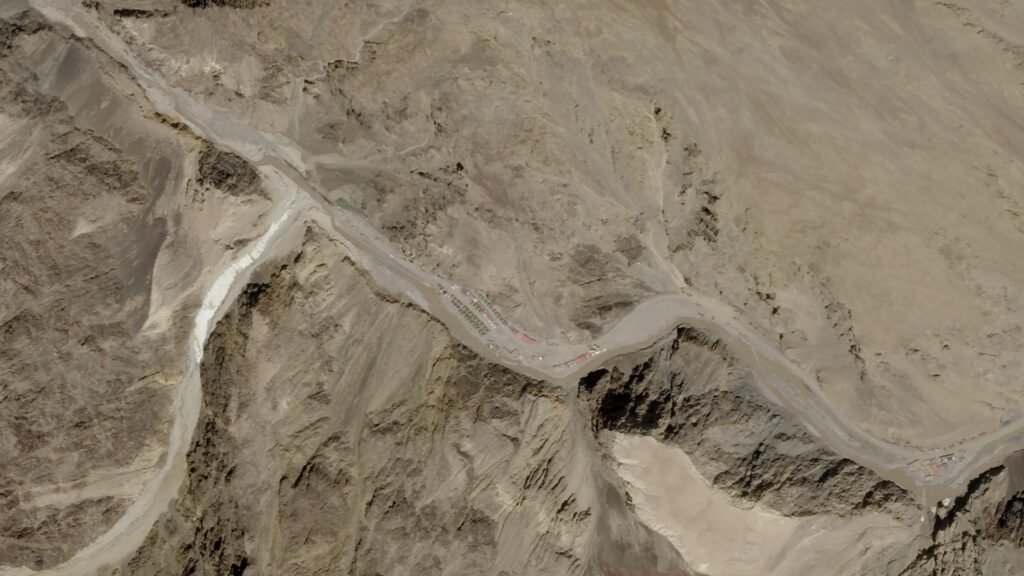China has significantly expanded its airfield infrastructure along the India China border, aiming to bolster its air power and develop offensive capabilities, as revealed by recent satellite imagery.
According to satellite images provided by Planet Labs PBC, an Earth imaging company based in San Francisco, Beijing has undertaken extensive expansion projects, including the construction of airfields, helipads, railway facilities, missile bases, roads, and bridges along the Line of Actual Control (LAC). These initiatives are intended to counter India’s relative advantages in certain areas.
The satellite images, analyzed by Hindustan Times, an Indian daily newspaper, indicate that China has expanded the airfields at Hotan, Ngari Gunsa, and Lhasa in southwest China. The expansions involve the construction of new runways, fortified shelters to protect combat jets and the establishment of additional operational buildings.
Strategically positioned across India’s northern region, these three Chinese airfields stretch from west to east, further enhancing China’s military presence in the area.
China and India, both nuclear-powered nations with a long-standing history of rival border claims, have been engaged in efforts to de-escalate tensions along their loosely defined de facto border, known as the LAC, for the past three years.
The Hotan airfield, located in southwestern Xinjiang and approximately 400km from Leh in India, has witnessed recent developments, including the construction of a new runway, aircraft, military operations support buildings, and an apron, as observed in a satellite image from May 2023.
Notably, unmanned aerial vehicles (UAVs) have been observed operating from the Hotan airfield in recent images. In contrast, earlier images from June 2020 revealed no construction or development in the vicinity. The last reported expansion of the airfield occurred in 2002.
Situated 200km away from Pangong Lake, which has been the site of multiple clashes between the two militaries, the Ngari Gunsa airfield in Tibet Autonomous Region became operational in 2010. Subsequently, it underwent expansion following the 2017 standoff in the disputed region of Doklam.
Satellite imagery from June 2020 displayed only one aircraft apron with combat jets at the Ngari Gunsa airfield. However, an image from May this year demonstrated various developments, including the construction of a new taxiway, improvements to the runway, and the presence of at least 16 reinforced aircraft shelters and new support buildings.
The airport in the administrative capital of the Tibet Autonomous Region, Lhasa, has long served both civilian and military purposes. It is situated less than 250km from Tawang, which lies at the westernmost part of India’s Arunachal Pradesh state and is at the center of China’s claims in the eastern sector.
Recent satellite images reveal ongoing construction activities at the Lhasa airport, including the development of a new runway, apron, at least 30 reinforced aircraft shelters, and new support buildings. Additionally, underground facilities have been constructed south of the Lhasa airfield in recent years, as reported.
These extensive developments in the Chinese airfields reflect China’s strategic objective of augmenting its military capabilities to counterbalance India’s advantages in the region, according to Damien Symon, a researcher at The Intel Lab, as cited by Hindustan Times. The ongoing construction efforts, combined with the deployment of diverse assets such as UAVs and advanced aircraft, underscore China’s endeavors to strengthen its offensive capabilities, particularly given the active border situation with India.
Mr. Symon further emphasized that these developments fundamentally transform the dynamics of air warfare, expanding China’s operational range and posing challenges to India’s deterrence strategies.
Meanwhile, negotiations to disengage along the LAC have remained at an impasse. This week, New Delhi hosted the first in-person India-China border talks in over four years, signifying ongoing efforts to address the situation.


